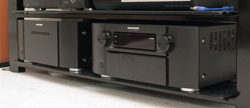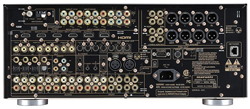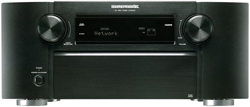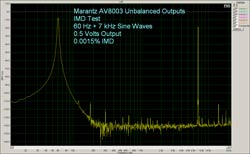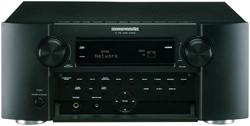Introduction:
The first receiver that I remember having in the house was a classic Marantz model. Unfortunately I was too young back then to realize the quality of that component, or even recognize the name, and at some point that receiver was replaced with a much more generic, mass market model with newer features. Marantz is still one of the most well known companies in high end audio and video today, and is still putting out high end components that are aimed at people who value performance over bells and whistles.
Specifications
- AV8003
- Design: A/V Processor
- Channels: 7.1; RCA and XLR Outputs for All Channels
- Codecs: All Dolby Digital Codecs including Dolby TrueHD, All DTS Codecs including DTS-HD Master Audio
- THX Ultra2 Certified
- DACs: TI 32-bit 24/192 on All Channels
- Three Additional Zones
- Inputs: Four HDMI (1.3a), 3 Coaxial Digital, 4 Stereo Analog Audio Pairs (RCA/XLR for CD Player), 3 Optical, 4 S-Video, 4 Component Video, 2 Composite Video, 7.1 Audio
- Outputs: RCA and XLR Audio, 2 HDMI, 1 Coaxial Digital, 1 Optical, 4 S-Video, 2 Component Video, 4 Composite Video, Trigger (to turn on other equipment)
- Ethernet Connection for Playing Music and Video from DLNA sources
- Dimensions: 7.5″ H x 17.5″ W x 15.25″ D
- Weight: 25.6 Pounds
- MSRP: $2,600 USA
- MM8003 Power Amplifier
- Power Outut: 140 Watts RMS x 8 into 8 Ohms, All Channels Driven
- THD+N: 0.08% at 8 Ohms
- MFR: 8 Hz – 100 kHz, ± 3 dB
- RCA and XLR inputs on All Channels
- Dimensions: 7.5″ H x 17.25″ W x 15.25″ D
- Weight: 39.5 Pounds
- MSRP: $2,400 USA
Design
I was given the chance to review the pinnacle of Marantz’s home theater audio lineup, the AV8003 Processor and the matching MM8003 8-channel amplifier. The AV8003 includes all of the features that you would expect in a reference class preamp with 4 HDMI 1.3 inputs, Audyssey MultiEQ room correction, unbalanced and balanced 8 channel outputs with each channel having a 24-bit/192kHz DAC of its own, a balanced stereo input, and an Ethernet jack with DLNA support to allow streaming audio and video from a DLNA server on your home network. Despite the lack of any amplifiers inside the chassis, the AV8003 still weighs more than many receivers due to a heavy copper-plated steel chassis to help shield it from external noise.
The MM8003 shares the impressive construction of its sibling, with all 8 channels offering 140 WPC at 8 ohms. Each channel has a balanced and unbalanced input with a switch to select between the two, and the binding posts accept banana plugs and bare wire, but do not accept spade lugs. The MM8003 also features both a 12V trigger for most preamps and a remote control jack that matches an output on the AV8003 to automatically trigger the power. While the MM8003 is only rated for 6-16ohm loads, I was told that it will handle 4 ohm loads with no problems, and many amps only are certified for 6-16 ohms for UL Labs certification reasons.
Setup
Hooking up the AV8003 and MM8003 was similar to the setup of any other processor and amplifier. I connected them using their balanced outputs and inputs, and the Marantz Remote Control cable to trigger the power amplifier automatically. The only non-standard connection was the Ethernet cable for the receiver, but I believe this will be standard for almost all receivers in the next couple of years. The Marantz components were not as deep as some gear I have had in the past, making it easier to route cables behind them once they were positioned in my AV rack which was a nice bonus.
Once everything was hooked up, I proceeded to configure the inputs of the Marantz using the on screen display which was as very simple white text on blue background interface. It was very functional for performing the setup but with companies like Denon and Onkyo moving to a much more graphical OSD to assist in the setup and configuration of their components I can imagine that Marantz might want to update this in the future. After assigning out HDMI inputs to my components (and in the case of my Nintendo Wii, assigning a Component Video input and configuring the video conversion settings for it), I was able to rename all of the inputs making daily use far easier than generic names like Video 5.
For speaker configuration, I pulled out the included Audyssey microphone, plugged it into the hidden front panel of the AV8003, and let Audyssey run through the detection of speakers, determination of crossovers, and frequency response for all channels. While the setup of Audyssey is pretty simple, there is a very well maintained guide that is kept at the AVS Forum that provides additional details for how you should properly configure your subwoofer first to help maximize the benefits that Audyssey provides that I highly recommend. The Marantz detected all of my speakers and crossovers correctly (something that Audyssey has gotten much better at from earlier implementations), and the AV8003 let me view the curves that Audyssey had found.
Many receivers and processors include a version of Audyssey, but not as many let you see a graphical EQ of what corrections Audyssey will provide, or choose between the different curves that Audyssey supports. The AV8003 let me choose between four different modes: Audyssey Standard, Flat, Front L+R, and None, as well as view the corrections that Audyssey would provide in all of these cases. I chose to go with the standard Audyssey curve, but as you can quickly switch between curves from the AV8003’s remote control, it was easy for me to compare the different modes and decide what I preferred later on.
In Use
As soon as I had the Marantz 8003 combo installed and setup, the first thing I did was put on my favorite recent song: “Reckoner” off the In Rainbows album from Radiohead. I was pretty instantly floored by the huge improvement that I heard over what I was used to listening to.
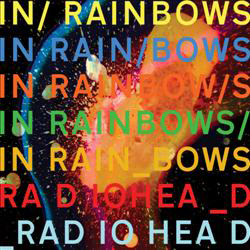
The cymbal that comes from the right speaker seemed to just float in space as never before. Every instrument had much better separation, and details were less muddled as I was amazed how much better my Epos speakers could sound. Switching between the Flat and Audyssey curves on the fly let me determine that I preferred the sound of the standard Audyssey curve for the music I would listen to (typically alternative/college rock and classic rock), though it took switching around quite a bit to really get a feel for the differences.
After getting a sense of what the Marantz could do with music, I wanted to listen to as much music as I could so I switched to the Network mode to stream music from my DLNA server where I have all of my music stored in FLAC format. I used Asset UPnP to convert the FLAC to PCM for the Marantz (which cannot decode FLAC, but can play WAV, PCM, and most MP3’s) and began to go through my collection. There were some little issues that I ran into with the DLNA player (album art has to be a JPEG image and not a GIF, and the colors were often a little strange), but the one issue that held me up the most was that you had to scroll through albums or artists in pages of 8 at a time. As my library has hundreds of albums and over 800 artists, getting to albums and artists in the middle of the alphabet could take a long time. Marantz is aware of this, but was unable to promise that it would be addressed with a firmware upgrade to allow you to skip ahead in the library.
While navigation might be troublesome, playback of media over DLNA was excellent. The Marantz was connected with Ethernet to my main wireless router and my server was using 802.11g, but I didn’t experience any drop-outs or other issues at all while streaming lossless music. I was unable to test video myself, but that was due to the difficulty in getting a DLNA server to work correctly with my media and not the fault of the Marantz at all. While not a replacement for a Sonos or other music distribution system, the ability to access my library directly through the AV8003 was a useful feature, and one that would be very useful if Marantz was able to improve the navigation in the future.
To test the ability of the Marantz to convert component video to HDMI, I used a Nintendo Wii set to output at 480p. I set the Marantz to output to 1080p and the image that came out looked good with no added artifacts that I could see that were added to the image. Video conversion always adds a little bit of a delay to a signal, but as this is something that your display would have to do eventually (my DLP has to convert everything to 1080p to display it) it doesn’t add any issues and the response time on the Wii was good enough for me to play Guitar Hero without any issue (except for annoying my wife).
As with all modern processors, the Marantz AV8003 can accept a Dolby TrueHD or DTS-MA bitstream from a Blu-ray player and decode it, as well as accepting lossless PCM over HDMI as well. Many people have been waiting for their players and processors to communicate using a bitstream instead of PCM, though there should be no difference between the two as it’s the equivalent of a Zipped file on a computer: it will have to be unzipped at one point and it shouldn’t matter if the player or the processor does the unzipping. If you want to see your processor say TrueHD on the front panel so you know that it’s sending the highest quality audio format on the disc, then the Marantz will do that for you.
However, one thing that people don’t often think about is that processors can often have restrictions on what they can do with those TrueHD/DTS-MA bitstreams when compared to receiving lossless PCM. Since unpacking that bitstream takes processing power, some receivers and processors might only be able to do room correction on signals below a certain sampling rate (for example, 16 bit/48kHz and below) if they also have to decode the bitstream. In the case of the Marantz, if you send the AV8003 a DTS-MA or TrueHD bitstream, then Audyssey is going to be disabled. However, if you send PCM then the AV8003 will be able to apply the Audyssey room correction since it doesn’t have to do the decoding as well. While some people might say that they can hear a slight difference with bitstream compared to PCM, most can hear the results of Audyssey fixing issues in their listening room, so I would highly recommend using PCM signals instead of a bitstream with the AV8003. As receivers and processors get faster processors then this restriction will hopefully go away (and room correction will get even better), but for now this is something to be aware of with any receiver or processor.
Once I setup my Oppo BDP-83 to send PCM to the Marantz, I went ahead and tested it with the new Blu-ray disc from 2L recordings in Norway, The Nordic Sound.

Recorded using their DXD format at 24-bit/384kHz and then down-sampled to 24-bit/192kHz 5.1 DTS-MA and PCM tracks, as well as a 24-bit/192kHz stereo track. While some of these selections were not my typical choice of music, the sound from the disc is absolutely spectacular and makes you hope that an audio-only Blu-ray profile becomes a standard in the future so more music will be released this way. The Marantz also did this disc justice, showing it can handle the dynamics of an orchestra without signs of strain. Many of these tracks used all 5 channels very aggressively and I never heard any clipping or anything else that would distract you from the sound.
When watching movies, the Marantz was fantastic as well. I finally got around to watching Baraka on Blu-ray and it was a treat for the eyes and the ears. With one of the best images I have seen on Blu-ray to this point, the Marantz passed the signal from the disc without any problems at all (unlike some other receivers and processors, the Marantz does not clip BTB or WTW signals in my testing), and the lush soundtrack made for a wonderful movie experience. It also gave me a chance to see how I liked the THX modes that the Marantz provided. While I feel the differences provided by THX were small compared to the improvements that Audyssey can make with a system, after going back and forth for a while I wound up watching movies with THX engaged.

One of the final things I went to test on the Marantz was its HD Radio tuner. I had been tempted to try HD Radio recently as a couple of the stations that I listen to will advertise substations that contain additional programming that is interesting to me that I can’t get over FM. Using a standard AM/FM indoor antenna that works fine with my Yamaha tuner, I tried to tune in these new stations on the Marantz but had issues. While my AM and FM stations would come in fine, the only HD Radio feed that I could tune in was a local jazz station that I had never listened to. While the jazz station sounded superb and I have since programmed it into my normal tuner, I was disappointed that I was unable to receive anything else in HD. However, since I don’t have another HD Radio to compare to this one, I am unable to tell you if that was due to the tuner in the Marantz, the antenna I was using, the reception in my area or something else. AM and FM stations were fine, so I would lean towards it being the antenna or the reception.
Overall, I was very pleased with the day-to-day use of the Marantz combination. It had a very neutral sound and provided fantastic dynamics and control over both music and films. One thing that I didn’t like was the remote that Marantz provides with the AV8003. While capable of controlling your whole system, to change inputs (from DVD to Network, for instance), I would have to go home on the remote, scroll through pages to find the Network section and select it, and then select Network again after moving to that section. After using it for a couple of days, I reprogrammed my Harmony to control everything and put the Marantz remote away. A good friend of mine uses his Marantz remote to control his entire system without issues, but it is not up to the level of a good universal remote by any means. However, all that I really cared about was the sound of the Marantz, and in that area it did not disappoint me at all.
On The Bench (AV8003 Only)
At 1 kHz and 0.5 volts output, THD+N was less than 0.003.
Using a combination of 19 kHz and 20 kHz sine waves, the B-A distortion product at 1 kHz was 92 dB below the fundamemtals.
IMD, using 60 Hz and 7 kHz sine waves was a low 0.0015%. This is exemplified by the lack of peaks surrounding the 7 kHz fundamental peak.
The frequency response was flat to 20 kHz, where there was a steep rolloff. The test signal passed through the Marantz’ DSP circuitry, rather than “Direct”, and an induced rolloff above the audible band in receivers these days is very common.
Conclusions
High-end processors and amplifiers such as the Marantz usually wind up in systems with far more expensive, and often harder to drive, speakers than my Epos ELS 5.1 setup, so I was curious how much of a difference it would make compared to a good receiver. Any doubts as to what difference it could make went away as soon as I began to listen to it. It brought my speakers to life with anything that it played and made me reconsider my upgrade priorities for the future.
The processor field has gotten more competitive recently with many internet direct companies starting to sell models, and many of the higher end models starting to carry video processing features that are beyond those that the Marantz offers. There are also some usability issues in the Marantz with its DLNA support that turns what would be a great feature into one that is too cumbersome to be used regularly, and I really do wish that the amplifier would accept spades in addition to spade lugs, as they are so commonly used on higher end cables. I also wish there was an input on the front of the AV8003 behind the panel, as trying to hook up a device just for an evening meant digging behind my rack of AV gear and hoping I used the correct jacks.
However, most of this is just being picky. The Marantz sounded fantastic when I used it and made me very unhappy to have to box it up and return it at the end of my review. It proved to me that Marantz continues to live up to the high end reputation that it has had since that receiver when I was growing up and I would highly recommend listening to them if you are in the market for a processor or an amplifier.



